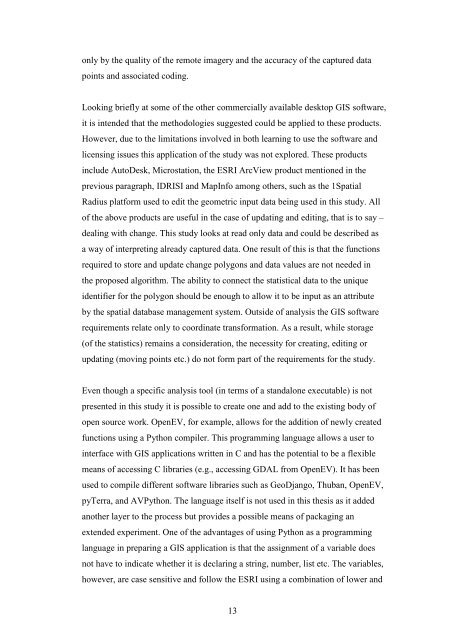You also want an ePaper? Increase the reach of your titles
YUMPU automatically turns print PDFs into web optimized ePapers that Google loves.
only by the quality of the remote imagery and the accuracy of the captured data<br />
points and associated coding.<br />
Looking briefly at some of the other commercially available desktop GIS software,<br />
it is intended that the methodologies suggested could be applied to these products.<br />
However, due to the limitations involved in both learning to use the software and<br />
licensing issues this application of the study was not explored. These products<br />
include AutoDesk, Microstation, the ESRI Arc<strong>View</strong> product mentioned in the<br />
previous paragraph, IDRISI and MapInfo among others, such as the 1Spatial<br />
Radius platform used to edit the geometric input data being used in this study. All<br />
of the above products are useful in the case of updating and editing, that is to say –<br />
dealing with change. This study looks at read only data and could be described as<br />
a way of interpreting already captured data. One result of this is that the functions<br />
required to store and update change polygons and data values are not needed in<br />
the proposed algorithm. The ability to connect the statistical data to the unique<br />
identifier for the polygon should be enough to allow it to be input as an attribute<br />
by the spatial database management system. Outside of analysis the GIS software<br />
requirements relate only to coordinate transformation. As a result, while storage<br />
(of the statistics) remains a consideration, the necessity for creating, editing or<br />
updating (moving points etc.) do not form part of the requirements for the study.<br />
Even though a specific analysis tool (in terms of a standalone executable) is not<br />
presented in this study it is possible to create one and add to the existing body of<br />
open source work. <strong>Open</strong>EV, for example, allows for the addition of newly created<br />
functions using a Python compiler. This programming language allows a user to<br />
interface with GIS applications written in C and has the potential to be a flexible<br />
means of accessing C libraries (e.g., accessing GDAL from <strong>Open</strong>EV). It has been<br />
used to compile different software libraries such as GeoDjango, Thuban, <strong>Open</strong>EV,<br />
pyTerra, and AVPython. The language itself is not used in this thesis as it added<br />
another layer to the process but provides a possible means of packaging an<br />
extended experiment. One of the advantages of using Python as a programming<br />
language in preparing a GIS application is that the assignment of a variable does<br />
not have to indicate whether it is declaring a string, number, list etc. The variables,<br />
however, are case sensitive and follow the ESRI using a combination of lower and<br />
13
















